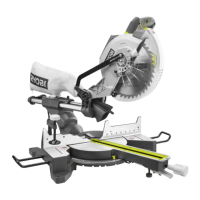
Do you have a question about the Ryobi TSS103 and is the answer not in the manual?
| Type | Sliding Compound Miter Saw |
|---|---|
| Blade Diameter | 10 inches |
| Motor Power | 15 Amp |
| Arbor Size | 5/8 inches |
| Voltage | 120V |
| No Load Speed | 5000 RPM |
| Bevel Capacity | 0-45 degrees |
| Max Cut Depth at 90 Degrees | 3-1/2 inches |
| Power Source | Corded Electric |
Guidelines for maintaining a safe and clear workspace to prevent accidents during operation.
Precautions regarding safe use of electricity and power tool connections to prevent shock.
Essential safety measures for the operator, including alertness, PPE, and proper attire.
Instructions on the correct and safe usage of power tools, including maintenance and handling.
Information on obtaining professional repair and maintenance services for the power tool.
Explanation of the double insulation safety feature and its implications for grounding.
Details on connecting the tool to a power supply, including voltage and frequency requirements.
Guidance on selecting and using appropriate extension cords for safe and effective operation.
Technical details and specifications of the miter saw, including dimensions and capacity.
Details on the saw's operating features, adjustment mechanisms, and locking systems for comprehensive understanding.
Instructions for safely removing the saw from its packaging and initial inspection.
Information on the base mounting holes and how to securely attach the saw to a workbench.
Guidance on utilizing the depth stop for making non-through cuts like dadoes.
Procedure for safely locking and unlocking the saw arm for transport or operation.
Steps for installing included accessories like the dust bag, blade wrench, and work clamp.
Instructions for attaching the table extensions to the left and right sides of the saw base.
Detailed steps for safely removing and installing or replacing the saw blade.
Procedure for removing and reinstalling the throat plate to ensure proper cutting.
How to adjust the support foot for stability during sliding cuts.
Procedure for aligning the saw blade perpendicular to the miter fence for accurate cuts.
Steps to adjust scale indicators to ensure accurate angle readings after squaring.
Lists the intended uses and limitations of the miter saw, including material types.
General guidelines and safety precautions for performing cuts with the compound miter saw.
Information on how to use the LED system for improved cut visibility and accuracy.
Instructions for performing standard cuts without using the sliding feature.
Steps for making miter and cross cuts, including setting angles on the miter table.
Procedure for making bevel cuts by adjusting the saw arm angle.
Detailed instructions for making cuts that involve both miter and bevel angles simultaneously.
Guidance on providing adequate support for long workpieces to prevent sagging or tipping.
Instructions for performing cuts using the saw's sliding feature for wider workpieces.
How to attach and use an auxiliary fence for added support and accuracy in specific cuts.
Chart and guidance for setting precise compound miter angles for various applications.
Specific techniques for accurately cutting crown molding using the compound miter saw.
Method for positioning crown molding flat on the table for accurate corner cuts.
Technique for cutting specific sizes of crown molding by nesting it against the miter fence.
Instructions on how to safely cut warped or bowed materials to prevent pinching the blade.
Guidance on how to securely clamp wide workpieces for stable cutting operations.
Information on checking and adjusting the saw arm pivot points for smooth movement.
Procedure for adjusting the positive stop mechanisms for accurate angle settings.
Information regarding the lubrication of the tool's bearings, noting no further lubrication is required.
Steps for checking and replacing worn carbon brushes in the motor assembly.
Instructions for cleaning the LED lens to maintain optimal visibility and light output.
